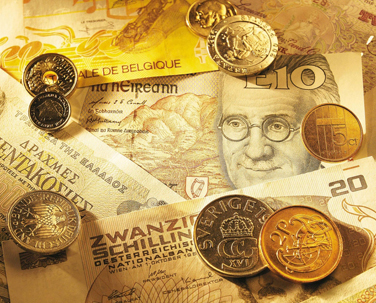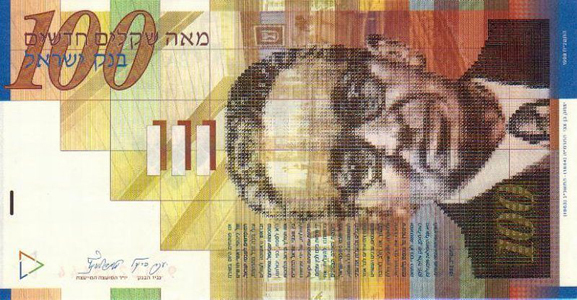How did world currencies get their names?
 To date, there are more than 250 countries in the world: 195 independent states, 10 countries with undefined status, 46 territories with special status, having a permanent population and their own citizenship, and about 160 currencies that are de jure or de facto used in various territories. Thus, at least every other state has its own money. You even heard about some currencies, others use it every day. But have you ever wondered why the ruble is called the ruble? What does the American dollar owe its name to? I was very interested in this topic, and I decided to conduct my own mini-research. Under the cut, you will find stories about how some world currencies got their names.
To date, there are more than 250 countries in the world: 195 independent states, 10 countries with undefined status, 46 territories with special status, having a permanent population and their own citizenship, and about 160 currencies that are de jure or de facto used in various territories. Thus, at least every other state has its own money. You even heard about some currencies, others use it every day. But have you ever wondered why the ruble is called the ruble? What does the American dollar owe its name to? I was very interested in this topic, and I decided to conduct my own mini-research. Under the cut, you will find stories about how some world currencies got their names.Ruble
The “ruble” monetary unit is used in Russia, Belarus, the unrecognized Pridnestrovian Moldavian Republic, as well as a number of other unrecognized and partially recognized states. Russian storablyabka, for sure, saw each of you. But here are the notes in denominations of 100 Belarusian and 100 Transnistrian rubles:

There are many versions of the origin of the word “ruble”. But most of them agree that the name of the currency comes from the verb “chop”. According to Max Vasmer's Etymological Dictionary, from the Old Russian ruble - "stump". The first references to the ruble as a monetary unit are found in Novgorod letters of the thirteenth century. Later, the name stuck and was used instead of the hryvnia. The ancient Russian hryvnia was an oblong silver ingot weighing about 200 grams and about 20 cm long. This is how it looked:

According to different versions, the ruble corresponded to half or a quarter of the weight of the hryvnia. Most historians hold the opinion that such parts were nevertheless 4. Some find confirmation of this theory in Arabic, where "rub" is the fourth part of something. In order to get an ingot equal to 1 ruble, a silver rod (hryvnia) was cut into pieces. Hence the name “ruble” - “chop off”, “stump”. To indicate the weight on the silver bars were set notches.
According to another version, the ruble received its name thanks to the technology of casting Novgorod hryvnia. Silver was poured into a mold in 2 steps, because of which there was a seam on the ingot, a scar, from where the name “ruble” - “ingot with a scar” could also go.
Dollar
The dollar is the most common currency in the world. It is used in the USA, Australia, Canada, New Zealand, Panama, Ecuador, Dominica, Puerto Rico and several other countries.
100 Canadian and 100 Australian Dollar Notes
According to Oxford Dictionaries, the word dollar, as well as the Slovenian tolar, which was in circulation until 2007, comes from the name of the coin “joachimsthaler”, shortened to “Taler” (or “Daler” from the Flemish language). The coin was named after the valley in which silver was mined for its minting - "Joachim Valley" (at present it is the territory of the Czech city of Jáchymov). Over time, the term was transformed and began to be used in other languages, especially in the Netherlands, and then the coins that were used in the Spanish-American and British North American colonies during the American Revolutionary War were called dollars. In 1792, the "dollar" was adopted as the name of the US currency.
Lb
The pound is the currency of Great Britain (pound sterling). Egypt, Lebanon, South Sudan, Sudan and Syria also call their currency the pound (Egyptian pound, Lebanese pound, etc.). To distinguish the British currency from the currencies of other countries of the same name in official documents use the full form of "pound sterling".
50 pounds and 100 Egyptian pounds bills The
British pound comes from the Latin word "pondus", which means "weight". There are several versions of the origin of the name of this currency. According to one of them, the name originated in the XII century and literally meant "a pound of pure silver." Large purchases were expressed in "pounds sterling". 240 ancient English coins, "sterling", had a mass of approximately 1 troy pound.
Pesos
Translated from the Spanish "peso" literally means "weight." Currently, the currency is used in some countries - the former colonies of Spain: Argentina, the Dominican Republic, Colombia, Mexico, Cuba, the Philippines, Chile and Uruguay.
Banknotes in denominations of 100 Argentinean and 100 Mexican pesos
When at the beginning of the 16th century the Spaniards came to American lands, to the territory of modern Mexico, there was no money as such. The means of payment for local residents were cocoa beans. Then the Spanish conquistador Fernando Cortes was given the order to cast all the gold in the coins that he would find on the “new Hepishan” land.. But Cortez disobeyed. Of pure gold, he began to mint only part of the coins, while others were made of copper with a small admixture of gold. As a result, several types of coins appeared, which were evaluated by the weight of gold in them. The most expensive is gold peso, the least valuable is peso from tepusk, i.e. copper and gold crumb. According to some sources, the name peso came from the same place.
Dinar
Algeria, Bahrain, Iraq, Jordan, Kuwait, Libya, Serbia, Macedonia, Tunisia use the currency of the dinar. The word "dinar" comes from the name of the silver coin "denarius", widespread in the Roman Empire. In turn, the word "denarius" comes from the Latin "denarius" - "consisting of ten."
Banknotes in denominations of 100 Serbian and 20 Bahraini dinars
The word “dinar” is also mentioned in the Quran. Along with two other terms - dirham and kantar - in the holy book of Muslims, dinar is used to denote cash equivalents.
Polish zloty
"Zloty" from Polish "złoto" translates as "gold". For the first time the term appeared in the 15th century to refer to gold coins of foreign coinage, mainly gold ducats, which entered Poland.
Crown
The monetary unit of a number of European countries, which include the Czech Republic, Denmark, Iceland, Norway and Sweden. The word "crown" comes from the Latin "corona" (English crown, German krone) and translates as "crown". It was the crown, depicted on the “kuronndor” coins (first crowns) minted in France in 1340, which gave the name to the new currency.
Banknotes of 100 CZK and 100 SEK
Lyra
Currently, the lira is the national currency of Turkey. Before the transition to the euro, 4 more states had their lira: Italy, the Vatican, San Marino and Malta.
Banknote of 100 Turkish liras
. Translated "lira" (from the Latin. "Libra") means "pound". Just like the British pound, the name comes from a unit of weight - the troy pound, which served to weigh silver.
Hungarian forint
The name of the currency comes from the Italian "florin" - the gold coin "fiorino d'oro" (gold florin), which in the middle of the XIII century began to be minted in Florence. A century later, in imitation of Florin in Hungary, they issued their own coins. Gradually, the coins acquired an original appearance, and the name was transformed into a forint.
Rial
Rial is the monetary unit of Oman, Iran, Qatar, Saudi Arabia and Yemen. From the Latin "rial" ("regalis") literally translated as "royal." The name of the currency came to Arabic from Europe and denoted popular European coins: thaler, piaster, sovereign.
Notes in denominations of 100 Iranian and 100 Saudi riyals
Real
Not to be confused with rial. Monetary unit of Brazil. Before the transition to the euro, currency was also used in Spain and Portugal.

Bank note in denomination of 100 Brazilian reais.
The first silver real was minted in Castile in the 14th century. In circulation silver coins were until the middle of the XIX century. Translated from Latin, "real" - "royal coin." Initially, on one side of the coin, the coat of arms of Spain was depicted, on the other, a crown in a double circular inscription. Later, on the reverse of the coin, a bust of a king began to be depicted.
South African Rand
The name of the national currency of South Africa, the rand (rand) comes from the name of the Witwatersrand mountain range, abbreviated to Rand, located in the eastern part of the country. At the end of the 19th century, one of the largest gold deposits in the world was found in the area of the ridge.

Banknote of 100 South African rands. The
currency rand was issued relatively recently - in 1961, simultaneously with the proclamation of South African independence and its withdrawal from the British Commonwealth .
Rupee
Currencies are in use in India and several South Asian countries, in particular, Indonesia, Nepal, the Republic of Mauritius, Pakistan, the Seychelles and Sri Lanka. From Sanskrit, a rupee (“rupya”) is translated as “minted silver”, “processed silver”. The word was used in the 16th century to refer to coins introduced by Sher Shah Suri . Since then, the coin has not been withdrawn from circulation, even in the days of "British India." According to another version, the word "rupee" comes from "rura" - "cattle". In India, cattle for a long time served as so-called natural money.
Denominations of 100 Indian and 100 Seychelles rupees
A distinctive feature of modern Indian banknotes is that Mahatm Gandhi is depicted on the front of each of them. They differ only in color and image on the reverse side of the bill. Banknotes are 7 denominations - from 5 to 1000 rupees, coins - 6 denominations - from 10 paise to 5 rupees. In 2010, in India, symbolic denominations of 0 rupees were issued as part of an anti-corruption program. Of course, it was impossible to pay them, but the authors of the initiative, activists of the anti-corruption organization, called for bribes to be given to police officers and extortionists only by such bills. According to anti-corruption, bank notes have become very popular among locals.
CNY
The Chinese symbol "圓", denoting the name of the national currency, literally translates as "round" or "round coin." That is the name worn silver coins during the Qing Dynasty . The first yuan appeared in China in 1835 and were made of silver.
100 RMB and 1000 Japanese Yen Notes
Shekel
Since 1980, the shekel is the currency of Israel. In ancient times, shekel called the weight measure for precious metals - gold and silver from 9 to 17 grams in different periods. The very word "shekel" in Hebrew means "weigh".

Bill in denominations of 100 shekels
